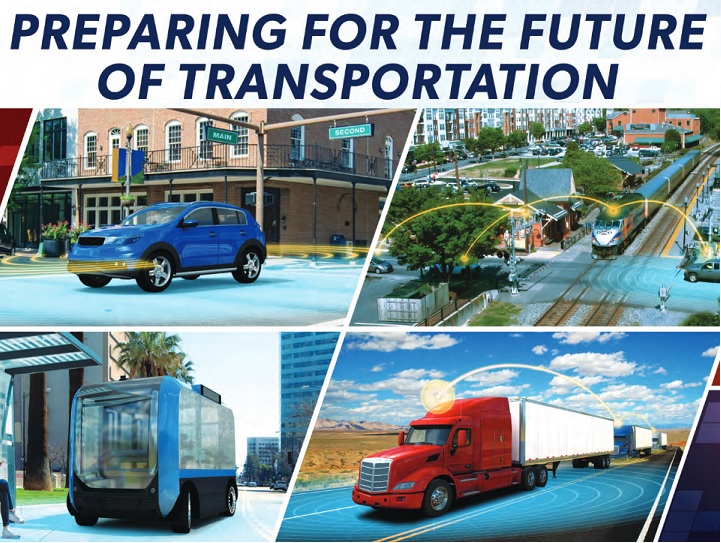ITSdigest
The USDOT is moving ahead towards a driverless future with the release of AV 3.0 — Preparing for the Future of Transportation: Automated Vehicles 3.0.

Click on image above to download AV 3.0
The document — which builds on USDOT's previous document: A Vision for Safety 2.0 — introduces guiding principles and describes US government’s strategy to address existing barriers to safety innovation and progress. It also communicates USDOT’s agenda to the public and stakeholders on important policy issues, and identifies opportunities for cross-modal collaboration.
AV 3.0 outlines six principles that guide the USDOT's approach to shaping policy for automated vehicles:
1. We will prioritize safety
2. We will remain technology neutral
3. We will modernize regulations
4. We will encourage a consistent regulatory and operational environment
5. We will prepare proactively for automation
6. We will protect and enhance the freedoms enjoyed by Americans
Some interesting points made in the document:
USDOT No Longer Specifies AV Proving Grounds
The USDOT "does not intend to pick winners and losers or to favor particular automated vehicle proving grounds over others," according to AV 3.0. With this in mind, USDOT no longer recognizes the designations of ten “Automated Vehicle Proving Grounds” announced in January 2017.
"The Department has taken no actions to direct any Federal benefits or support to those ten locations on the basis of these designations, and these designations will have no effect — positive or negative — going forward on any decisions the Department may make regarding Federal support or recognition of research, pilot or demonstration projects, or other developmental activities related to automated vehicle technologies," AV 3.0 continues.
Going forward, USDOT intends "to apply neutral, objective criteria and to consider all locations in all states where relevant research and testing activities are actually underway."
Best Practices for State and Local Authorities
In addition to best practices for states outlined in the 2.0 document, AV 3.0 offers new best practices.
State legislatures are encouraged to:
■ Engage USDOT for technical assistance to ensure state requirements do not pose unintended barriers to AV development and deployment.
■ Adopt terminology defined through voluntary technical standards.
■ Assess State roadway readiness for autonomous vehicles.
State highway officials are encouraged to:
■ Consider test driver training and licensing procedures for test vehicles.
■ Recognize issues unique to entities offering automated mobility as a service.
Infrastructure owners are encouraged to:
■ Support safe testing and operations of automated vehicles on public roadways by establishing consistent cross-jurisdictional approaches and working with first responders to develop commonly understood traffic law enforcement practices and emergency response plans for automated vehicle testing and operation.
■ Collaborate with automated vehicle developers and testers to identify potential infrastructure requirements.
■ Build knowledge of automated vehicle technologies and identify technical assistance resources.
■ Identify data needs and opportunities to exchange data.
■ Work with automated vehicle developers, traffic engineers, and law enforcement stakeholders to revise the Uniform Vehicle Code (UVC) to be consistent with automated vehicle operations.
■ Support scenario development and transportation planning for automation.
Local governments are encouraged to:
■ Facilitate safe testing and operation of automated vehicles on local streets.
■ Consider how land use, including curb space, will be affected by AVs.
■ Consider the potential for increased congestion, and how it might be managed.
■ Engage with citizens.
Private Sector Responsibilities
AV 3.0 also outlines the private sector's role, during and beyond developing and testing the technology:
■ Be transparent about vehicle safety performance.
■ Engage with consumers through public education campaigns.
■ Conduct voluntary safety self-assessments and make the results available publicly.
■ Consider all possible surface transportation conditions and different roadway landscapes.
■ Work with all potential user groups to incorporate universal design principles.
■ Anticipate human factors and driver engagement issues.
■ Contribute to the development of voluntary, consensus-based, and performance-oriented technical standards.
Modernizing Regulations
The document states: "With AV 3.0, USDOT acknowledges the need to modernize existing regulations and think about new ways to deliver on our mission."
To that end, USDOT agencies are addressing regulatory gaps, regulatory barriers and unnecessary challenges that inhibit the path to full commercial integration of automated vehicles. This begins with regulations on the development, testing, and integration of Advanced Driver Assistance (ADS) technology.
Important Questions Remain
AV 3.0 concludes by stating how many important questions remain, making it quite clear that this is a step in a long-term process.
How will people interact with AV technologies?
What happens when a human vehicle operator switches to or from an automated driving mode?
How will professional drivers be affected?
Which regulatory obstacles need to be removed?
Will automation lead to increased urban congestion?
What opportunities and challenges does automation present for long-range regional planning?




